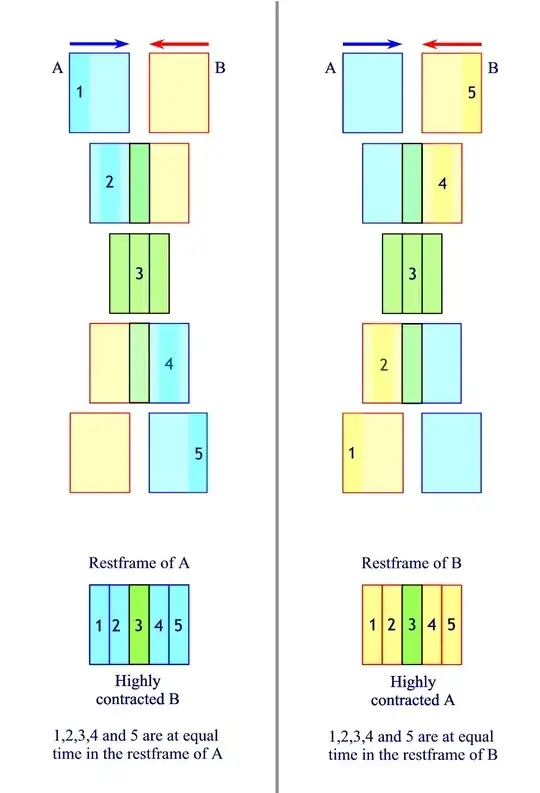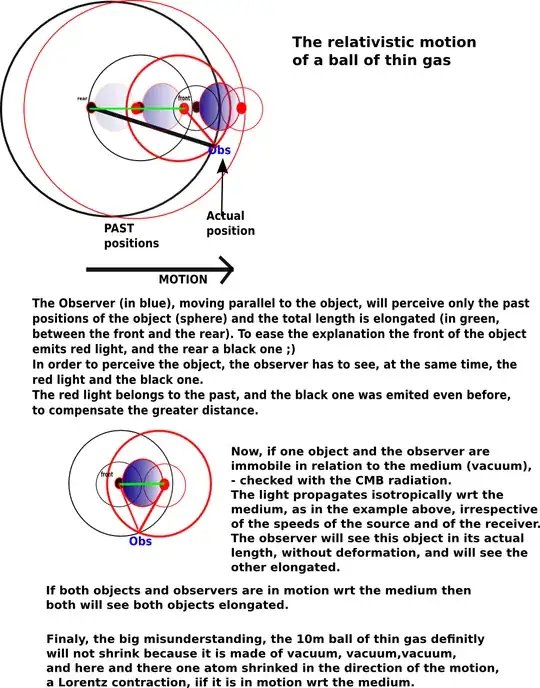2012-04-07 Addendum: The Dual Cloud Chamber Paradox
Two 10m diameter spheres $A$ and $B$ of very cold, thin gas have average atomic separations of 1nm. Their atoms are neutral, but ionize easily and re-radiate if a relativistic ion passes nearby. Both clouds are seeded with small numbers of positive and negative ions. The clouds collide at a relative speed of $0.994987437c$, or $\gamma=10$. Both are sparse enough to minimize collisions and deceleration. Both show passage of each other's ions. (a) What do distant observers moving parallel to $A$ and $B$ observe during the collision? (b) Are their recordings of this event causally consistent?
The answer to (a) requires only straightforward special relativity, applied from two perspectives. For the traveler moving in parallel to cloud $A$, cloud $B$ should appear as a Lorentz contracted oblate spheroid with one tenth the thickness of cloud $A$, passing through cloud $A$ from right to left. If you sprinkled cloud $A$ with tiny, Einstein-synchronized broadcasting clocks, the $A$-parallel observer would observe a time-stamped and essentially tape-recording like passage of the $B$ spheroid through cloud $A$.
The $B$-parallel observer sees the same sort of scenario, except with cloud $A$ compressed and passing left-to-right through cloud $B$. If $B$ is sprinkled with its own set of Einstein synchronized broadcasting clocks, the $B$p-parallel observer will record a time-stamped passage of the compressed $A$ through $B$.
So, am I the only one finds an a priori assumption causal self-consistency between these two views difficult to accept? That is, while it may very well be that a recording of a flattened $B$ passing through cloud $A$ in $A$-sequential time order can always be made causally self-consistent with a recording of a flattened $A$ passing passing through through cloud $B$ in $B$-sequential order, this to me is a case where a mathematically precise proof of the information relationships between the two views would be seem like a good idea, if only to verify how it works. Both views after all record the same event, in the sense that every time a clock in $A$ or $B$ ticks and broadcasts its results, that result becomes part of history and can no longer be reversed or modified.
It's tempting to wonder whether the Lampa-Terrell-Penrose Effect might be relevant. However, everything I've seen about L-T-P (e.g. see the video link I just gave) describes it as an optical effect in which the spheres are Lorentz contracted at the physical level. Since my question deals with fine-grained, contact-like interactions of two relativistic spheres, rather than optical effects at a distance, I can't easily see how L-T-P would apply. Even if it did, I don't see what it would mean.
So, my real question is (b): Does an information-level proof exist (not just the Lorentz transforms; that part is straightforward) that the $A$-parallel and $B$-parallel recordings of dual cloud chamber collision events will always be causally consistent?
2012-03-03: This was my original version of the question, using muonium clocks
My SR question is how to predict length contraction and time dilation outcomes for two interacting beams of neutral particles. The two beams are:
In different inertial (unaccelerated) reference frames for the duration of measurement part of the experiment.
Intermixed at a near-atomic level so that frame-to-frame photon exchange times are negligible. An example would be two intersecting beams of relatively dense, internally cold muonium atoms.
Clock-like even at the atomic level (e.g., decaying atoms of muonium).
Part of a single causal unit. By this I mean that there is a sufficient short-range exchange of photons between the two beams to ensure that state changes within each beam have an entropic effect, however small, on nearby components of the other beam. This makes their interactions irreversible in large-scale time. An example would be decay of an anti-muon in one frame transferring energy to nearby muonium atoms in the other frame. Simply illuminating the intersection region with light frequencies that would interact with muonium in both of the beams would be another option.
Observed by someone who is herself isolated from the rest of the external universe.
Muons generated by cosmic rays and traveling through earth's atmosphere provide a helpful approximation the above experiment. The muons provide the first beam, and the atmosphere forms the second one, which in the case of muons is shared by the observer.
Such muons have tremendously extended lifespans, which is explained by invoking time dilation (but not length contraction) for the muon frame as viewed from the atmosphere frame. Conversely, length contraction (but not time dilation) is invoked to describe the view of the atmosphere from the perspective of the muon frame. Since this results in the atmosphere appears greatly compressed in the direction of travel, the muons simply travel a shorter distance, thereby ensuring the same decay result (causal symmetry) for both views of the interacting frames.
My question then is this:
For the thought experiment of intersecting, causally linked beams of muonium, what parameters must the observer take into account in order to predict accurately which of the two intersecting muonium beams will exhibit time dilation, and which one will exhibit length contraction?
2012-03-04 Addendum by Terry Bollinger (moved here from comment section):
Sometimes asking a question carefully is a good way to clarify one's thinking on it. So, I would now like to add a hypothesis provoked by own question. I'll call it the local observer hypothesis: Both beams will be time dilated based only on their velocities relative to the observer Alice; the beam velocities relative to each other are irrelevant. Only this seems consistent with known physics. However, it also implies one can create a controllable time dilation ratio between two beams. I was trying to avoid that. So my second question: Are physical time dilation ratios ever acceptable in SR?
2012-03-06 Addendum by Terry Bollinger:
Some further analysis of my own thought problem:
A $\phi$ set is a local collection of clock-like particles (e.g. muons or muonium) that share a closely similar average velocity, and which have the ability to intermix and exchange data with other $\phi$ sets at near-atomic levels, without undergoing significant acceleration. A causal unit $\chi = \{\phi_0 ... \phi_n\}$ is a local collection of $(n+1)$ such $\phi$ sets. By definition $\phi_0$ contains a primary observer Alice, labeled $\aleph_0$, where $\aleph_0 \subset \phi_0$.
Each $\phi_i$ has an associated XYZ velocity vector $\boldsymbol{v_i} = (\phi_0 \rightarrow \phi_i$) that is defined by the direction and rate of divergence of an initially (nominally) co-located pair of $\phi_0$ and $\phi_i$ particles, with the $\phi_0$ particle interpreted as the origin. The vector has an associated magnitude (scalar speed) of $s_i=|\boldsymbol{v_i}|$.
Theorem: If $\phi_i$ includes a subset of particles $\aleph_i$ capable of observing Alice in $\phi_0$, then $\aleph_i$ will observe $\phi_0$ as length contracted along the axis defined by $\boldsymbol{v_i}$. Conversely, Alice ($\aleph_0$) will observe each $\phi_i$ as time dilated (slowed) based only on its scalar speed $s_i$, without regard to the vector direction. This dependence of time dilation on the scalar $s_i$ means that if $\phi_a$ has velocity $\boldsymbol{v_a}$ and $\phi_b$ has the opposite velocity $\boldsymbol{-v_a}$, both will have the same absolute time dilation within the causal unit (think for example of particle accelerators).
Analysis: This $\chi = \{\phi_i\}$ framework appears to be at least superficially consistent with data from sources such as particle accelerators, where time dilation is observable in the variable lifetimes of particles at different velocities, and where absolute symmetry in all XYZ directions is most certainly observed. Applying observer-relative time dilation to fast particles (e.g. in a simple cloud chamber) is in fact such a commonly accepted practice that I will assume for now that it must be valid.
(It is worth noting that while particle length contraction is typically also assumed to apply to fast-moving particles, serious application of length contraction in a causal unit would cause the particles to see longer travel paths that would shorten their lifespans. This is the same reason why muons are assumed to see a shorter path through a length-contracted atmosphere in order to reach the ground.)
My updated questions are now:
(1) Is my $\chi = \{\phi_i\}$ framework for applying SR to experiments valid? If not, why not?
(2) If $\chi = \{\phi_i\}$ is valid, what property makes the observer $\aleph_0$ in $\phi_0$ unique from all other $\aleph_i$?

